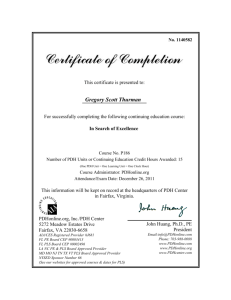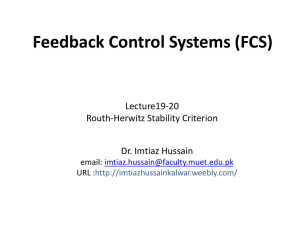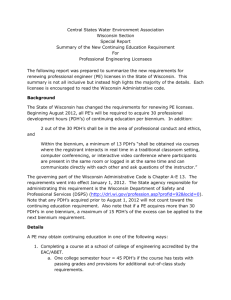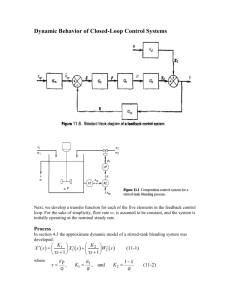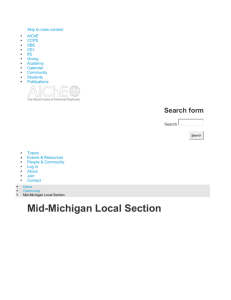Automatic Control Systems - Professional Development Hours
advertisement
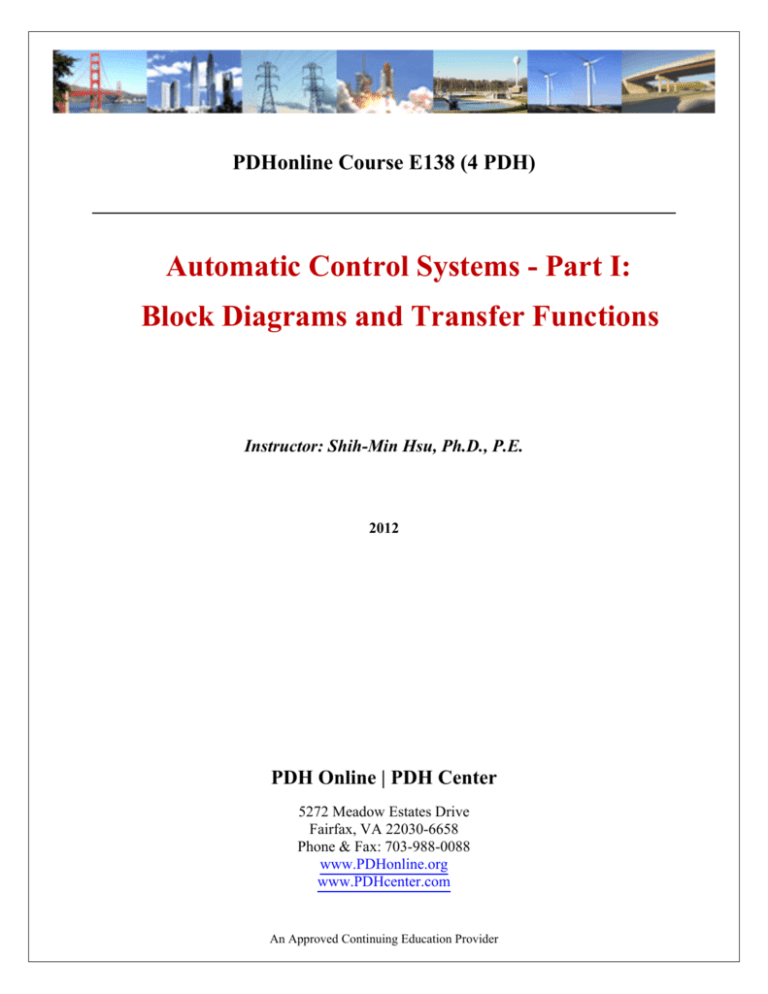
PDHonline Course E138 (4 PDH) Automatic Control Systems - Part I: Block Diagrams and Transfer Functions Instructor: Shih-Min Hsu, Ph.D., P.E. 2012 PDH Online | PDH Center 5272 Meadow Estates Drive Fairfax, VA 22030-6658 Phone & Fax: 703-988-0088 www.PDHonline.org www.PDHcenter.com An Approved Continuing Education Provider www.PDHcenter.com PDH Course E138 www.PDHonline.org Automatic Control Systems Part I: Block Diagrams and Transfer Functions By Shih-Min Hsu, Ph.D., P.E. Page 1 of 21 www.PDHcenter.com I. PDH Course E138 www.PDHonline.org Introduction: In recent years, control systems have gained an increasingly importance in the development and advancement of the modern civilization and technology. Figure 1-1 shows the basic components of a control system. Disregard the complexity of the system, it consists of an input (objective), the control system and its output (result). Practically our day-to-day activities are affected by some type of control systems. There are two main branches of control systems: 1) Open-loop systems and 2) Closed-loop systems. Control Element Input/Objective Output/Result Fig. 1-1. Basic components of a control system. Open-loop systems: The open-loop system is also called the non-feedback system. This is the simpler of the two systems. A simple example is illustrated by the speed control of an automobile as shown in Figure 1-2. In this open-loop system, there is no way to ensure the actual speed is close to the desired speed automatically. The actual speed might be way off the desired speed because of the wind speed and/or road conditions, such as up hill or down hill etc. Desired speed Controller Engine Actual speed Fig. 1-2. Basic open-loop system. Closed-loop systems: The closed-loop system is also called the feedback system. A simple closed-system is shown in Figure 1-3. It has a mechanism to ensure the actual speed is close to the desired speed automatically. Desired speed + Controller Engine Speed sensor Fig. 1-3. Basic closed-loop system. Page 2 of 21 Actual speed www.PDHcenter.com PDH Course E138 www.PDHonline.org Block Diagrams: Because of their simplicity and versatility, block diagrams are often used by control engineers to describe all types of systems. A block diagram can be used simply to represent the composition and interconnection of a system. Also, it can be used, together with transfer functions, to represent the cause-and-effect relationships throughout the system. Transfer Function is defined as the relationship between an input signal and an output signal to a device. Three most basic simplifying rules are described in detail as follows. Series Connection – R(s) G1(s) C(s) G2(s) C(s ) = G 1 (s )G 2 (s )R (s ) ⇓ R(s) G1(s)G2(s) C(s) C(s ) = G 1 (s )G 2 (s ) R (s ) Parallel Connection – R(s) G1(s) + G2(s) + C(s ) = [G 1 (s ) + G 2 (s )]R (s ) ⇓ R(s) G1(s)+G2(s) C(s ) = G 1 (s ) + G 2 (s ) R (s ) Page 3 of 21 C(s) C(s) www.PDHcenter.com PDH Course E138 www.PDHonline.org Feedback Control Systems – E(s) R(s) + C(s) G(s) H(s) C(s ) = G (s )E(s ) E(s ) = R (s ) − H(s )C(s ) (Error) C(s ) = G (s )[R (s ) − H(s )C(s )] C(s ) = G (s ) R (s ) 1 + G (s )H(s ) ⇓ R(s) G (s ) 1 + G(s)H(s) C(s) C(s ) G (s ) = R (s ) 1 + G (s )H(s ) Some basic rules of simplifying block diagrams are tabulated in Table 1-1. Page 4 of 21 (1-1) www.PDHcenter.com PDH Course E138 www.PDHonline.org Table 1-1. Rules of simplifying block diagrams. Case 1 2 Original Structure R(s) G1(s) G1(s) + G2(s) ± R(s) + R(s) C(s) G2(s) R(s) 3 Equivalent Structure R(s) C(s) C(s) G1(s) C(s) G1(s)G2(s) C(s) G1(s)±G2(s) R(s) C(s) G 1 (s ) 1 m G 1 (s)G 2 (s) ± G2(s) Z W 4 X X 5 Y Z X X Z G G Z 1 G X Y Y Z G G G G 7 G G G 8 1 G Page 5 of 21 Z G Y Y X 6 Y W www.PDHcenter.com PDH Course E138 www.PDHonline.org Example 1-1: Find the transfer function of the closed-loop system below. R(s) + 4 s +1 - C(s) 1 s Solution: Use case 1 to combine the two series blocks R(s) + C(s) 4 s(s + 1) - Use case 3 to obtain the transfer function as follows 4 C(s ) 4 s(s + 1) = 2 = 4 R (s ) 1+ ⋅1 s + s + 4 s(s + 1) ♦ Example 1-2: Find the transfer function of the closed-loop system below. R(s) + - G1(s) + G2(s) - C(s) H(s) Solution: Use case 3 to simplify the inner feedback loop to obtain the following block diagram. R(s) + - G1(s) G 2 (s ) 1 + G 2 (s )H(s ) Page 6 of 21 C(s) www.PDHcenter.com PDH Course E138 www.PDHonline.org Use case 1 to combine the two series blocks into one. G1 (s )G 2 (s ) 1 + G 2 (s )H(s ) R(s) + - C(s) Use case 3 to obtain the transfer function for the standard feedback system. G 1 (s )G 2 (s ) 1 + G 2 (s )H(s ) G 1 (s )G 2 (s ) C(s ) = = G (s )G 2 (s ) 1 + G 2 (s )H(s ) + G 1 (s )G 2 (s ) R (s ) 1+ 1 1 + G 2 (s )H(s ) ♦ Example 1-3: Find the transfer function of the closed-loop system below. G5 + + G1 _ + G2 G3 G4 Solution: Use case 3 to simplify the inner feedback blocks. + _ G2 1 − G 2G 5 G1 G4 Page 7 of 21 G3 www.PDHcenter.com PDH Course E138 www.PDHonline.org Use case 8 to get the following block diagram. + _ R G2 1 − G 2G 5 G1 G3 C 1 G3 G4 Use case 1 to combine the two sets of series blocks. + G1G 2G 3 1 − G 2G 5 _ G4 G3 Use 3 to calculate the overall transfer function of the system G 1G 2 G 3 1 − G 2G 5 G 1G 2 G 3 C = = GG G G 1 − G 2 G 5 + G 1G 2 G 4 R 1+ 1 2 3 ⋅ 4 1 − G 2G 5 G 3 ♦ Systems with Two Inputs: Figure 1-4 shows the block diagram of a system with two inputs, 1) the setpoint, R(s) and 2) the load disturbance, D(s). By superposition, D(s) R(s) + - G1(s) + + G2(s) H(s) Fig. 1-4. System with two inputs. Page 8 of 21 C(s) www.PDHcenter.com PDH Course E138 www.PDHonline.org (i) The component C ' (s ) produced by R(s) exists only (D(s)=0) C ' (s ) = G 1 (s )G 2 (s ) R (s ) 1 + G 1 (s )G 2 (s )H(s ) (1-2) (ii) Similarly, the component C " (s ) produced by D(s) exists only (R(s)=0) C " (s ) = G 2 (s ) D(s ) 1 + G 1 (s )G 2 (s )H(s ) (1-3) The total value of C(s) C(s) = C ' (s ) + C" (s ) = G 1 (s )G 2 (s ) G 2 (s ) R (s ) + D(s ) 1 + G 1 (s )G 2 (s )H(s ) 1 + G 1 (s )G 2 (s )H(s ) (1-4) G 1 (s )G 2 (s )H(s ) is the open-loop transfer function. The characteristic equation is 1 + G 1 (s )G 2 (s )H(s ) = 0 (1-5) Page 9 of 21 www.PDHcenter.com II. PDH Course E138 www.PDHonline.org Mason Rule: C(s) G(s) = = R(s) ∑ G (s)∆ i i ∆ i , (2-1) where Gi(s) = path gain of the ith forward path, ∆= 1-∑all individual loop gains + ∑ gain products of all possible two loops which do not touch − ∑ gain products of all possible three loops that do not touch + ·····, ∆ i = the ith forward path determinant = the value of ∆ for that part of the block diagram that does not touch the ith forward path. A forward path is a path from the input to the output such that no node is included more than once. Any closed path that returns to its starting node is a loop, and a path that leads from a given variable back to the same variable is defined as a loop path. A path is a continuous sequence of nodes, with direction specified by the arrows, with no node repeating. Example 2-1: A block diagram of control canonical form is shown below. Find the transfer function of the system. b1 + + b2 R Σ + + Σ + 1/s + 1/s 1/s b3 + -a1 -a2 -a3 Solution: Forward path 1 2 3 Path gain G 1 = 1 (b1 ) s 1 1 (b ) G2 = s s 2 G 3 = 1 1 1 (b3 ) s s s ( ) ( )( ) ( )( )( ) Page 10 of 21 C www.PDHcenter.com PDH Course E138 www.PDHonline.org Loop path l1 = 1 (− a1 ) s 1 1 (− a 2 ) l2 = s s l3 = 1 1 1 (− a3 ) s s s ( ) ( )( ) ( )( )( ) The determinants are a a a ∆ = 1 − (l1 + l 2 + l 3 ) = 1 − − 1 − 22 − 33 ; s s s ∆1 = 1 − (0) ; ∆ 2 = 1 − (0) ; ∆ 3 = 1 − (0) . Applying Mason’s rule, the transfer function is b1 ⋅ 1 + b2 ⋅ 1 + b3 ⋅ 1 b1s 2 + b2 s + b3 C(s ) G 1 ∆ 1 + G 2 ∆ 2 + G 3 ∆ 3 s s2 s3 = = = 3 a a a R (s ) ∆ s + a1s 2 + a 2 s + a3 1+ 1 + 2 2 + 3 3 s s s ♦ Example 2-2: Find the transfer function of the following system. H1 + R H2 + Σ H3 H4 + H5 Solution: Forward path 1 2 Path gain G 1 = H1 G 2 = H 2 H3H 4 Loop path l1 = H 3 H 5 Page 11 of 21 + Σ C www.PDHcenter.com PDH Course E138 www.PDHonline.org The determinants are ∆ = 1 − (l1 ) = 1 − (H 3 H 5 ) ; ∆ 1 = 1 − (l1 ) = 1 − (H 3 H 5 ) ; (note the forward path 1 does not touch loop path 1) ∆ 2 = 1 − (0) ; Applying Mason’s rule, the transfer function is C(s ) G 1 ∆ 1 + G 2 ∆ 2 H 1 (1 − H 3 H 5 ) + H 2 H 3 H 4 = = ∆ R (s ) 1 − H 3H5 ♦ Example 2-3: Find the transfer function of the following system. H4 H6 R + Σ H1 + + Σ H2 + + Σ H3 + C Σ + + H5 H7 Solution: Forward path 1 2 Path gain G1 = H 4 G 2 = H1H 2 H 3 Loop path l1 = H 1 H 5 ; (does not touch l3 ) l2 = H 2 H 6 l3 = H 3 H 7 ; (does not touch l1 ) l4 = H 4 H 7 H 6 H 5 The determinants are ∆ = 1 − (l1 + l 2 + l 3 + l 4 ) + (l1 ⋅ l3 ) = 1 − (H 1 H 5 + H 2 H 6 + H 3 H 7 + H 4 H 7 H 6 H 5 ) + (H 1 H 5 H 3 H 7 ) ; ∆ 1 = 1 − (l 2 ) = 1 − (H 2 H 6 ) ; (note the forward path 1 does not touch loop path 2) ∆ 2 = 1 − (0) ; Page 12 of 21 www.PDHcenter.com PDH Course E138 www.PDHonline.org Applying Mason’s rule, the transfer function is H 4 (1 − H 2 H 6 ) + H 1 H 2 H 3 ⋅ 1 C(s ) G 1 ∆ 1 + G 2 ∆ 2 = = ∆ R (s ) 1 − (H 1 H 5 + H 2 H 6 + H 3 H 7 + H 4 H 7 H 6 H 5 ) + (H 1 H 5 H 3 H 7 ) ♦ Example 2-4: The block diagram of a closed-loop system is shown below. For simplicity, all the blocks represent ideal amplifiers. Determine the ratio C . R 4 R _ + _ 7 C + _ 2 3 5 6 Solution: (7 ⋅ 2 ⋅ 3 ⋅ 5)⋅1 C 210 210 = = = = 0.6931 R 1 − [(− 6 ⋅ 2 ⋅ 3) + (− 4 ⋅ 7 ⋅ 2) + (− 1⋅ 7 ⋅ 2 ⋅ 3 ⋅ 5)] 1 + 36 + 56 + 210 303 ♦ Mason’s rule is useful for solving relatively complicated block diagrams by hand. It yields the solution to the graph in the sense that it provides an explicit input-output relationship for the system represented by the diagram. The advantage as compared to path-by-path reduction is that it is systematic and algorithmic. Page 13 of 21 www.PDHcenter.com III. PDH Course E138 www.PDHonline.org Routh Test: A mathematical method for determining the stability of a system from the open-loop transfer function is the Routh-Hurwitz Stability Criterion (Routh Test). A simplified closed-loop system is shown in Figure 3-1. Its transfer function is expressed as follows: C(s ) G (s ) N(s ) = = , R (s ) 1 + G (s )H(s ) D(s ) (3-1) where N(s) denotes the numerator and D(s) denotes the denominator. E(s) R(s) + C(s) G(s) H(s) Fig. 3-1. A simplified closed-loop system. Routh Test starts by expanding the denominator of the closed-loop transfer function, D(s). The D(s) = 0 is called the characteristic equation. For the characteristic equation (CE): a 0 s n + a1s n -1 + a 2 s n - 2 + a 3 s n -3 + ⋅ ⋅ ⋅a n −1s + a n = 0 . (3-2) The coefficients are arranged into the first two rows of an array. Additional rows are calculated. Routh Table sn a0 a2 a4 a6 • s n -2 s n -3 a1 b1 c1 a3 b2 c2 a5 b3 c3 a7 • • • • • s1 s0 q1 r1 s n -1 b1 = a1a 2 − a 0 a3 ; a1 a3b1 − a1b2 ; b1 • • • c1 = Obtained from the characteristic equation Calculated by the following equations b2 = a1a 4 − a 0 a5 ; a1 b3 = a1a 6 − a 0 a 7 ; a1 • • • c2 = a5 b1 − a1b3 ; b1 c3 = a 7 b1 − a1b4 ; b1 • • • Page 14 of 21 www.PDHcenter.com PDH Course E138 www.PDHonline.org To be a stable system, the necessary and sufficient condition for all the roots of the characteristic equation to have negative real parts is that all the elements in the first column be of the same sign and none zero. Whenever there is a sign change, it indicates the number of poles in the right-half-plane (RHP) of s-Plane. To be a stable system, all the poles need to be in the left-half-plane (LHP) of s-Plane. Example 3-1: For the closed-loop system, find the characteristic equation and the range for K to have a stable system. R(s) + K s(2s + 1)(0.5s + 1) - C(s) Solution: K C(s ) K K s(2s + 1)(0.5s + 1) = = 3 = K R (s ) s(2s + 1)(0.5s + 1) + K s + 2.5s 2 + s + K 1+ ⋅1 s(2s + 1)(0.5s + 1) The characteristic equation: s 3 + 2.5s 2 + s + K = 0 Routh Table s3 2 s s1 s0 1 1 2.5 K b1 c1 b1 = 2.5 × 1 − K × 1 2.5 (1) c1 = K × b1 − 2.5 × 0 =K b1 (2) To be stable, b1 > 0 and c1 > 0 , From (2) K>0 From (1) 2.5 − K > 0 , K < 2.5 Therefore, 0 < K < 2.5 For the system to be stable, 0 < K < 2.5 Page 15 of 21 ♦ www.PDHcenter.com PDH Course E138 www.PDHonline.org Example 3-2: Find the range of K so that the system shown is stable. + where G p (s ) = G p (s ) K _ 2 . s + 4s + 5s + 2 3 2 Solution: The characteristic Equation can be obtained by 1 + KG p (s )H(s ) = 0 1+ 2K =0 s + 4s 2 + 5s + 2 3 s 3 + 4s 2 + 5s + (2 + 2K ) =0 s 3 + 4s 2 + 5s + 2 Therefore, CE = s 3 + 4s 2 + 5s + (2 + 2K ) = 0 Routh Table: s3 s2 s1 s0 b1 = 1 4 b1 c1 5 (2 + 2K ) 4 × 5 − 1 × (2 + 2K ) 9 − K = 4 2 (1) b1 × (2 + 2K ) − 0 × 0 = 2 + 2K (2) b1 To have a stable system, b1 and c1 must be greater than zero. c1 = From (2) 2 + 2K > 0 ⇒ K > −1 From (1) 9−K >0 2 ⇒ K<9 Therefore, the range of K to have the system stable is ♦ −1 < K < 9 Page 16 of 21 www.PDHcenter.com PDH Course E138 www.PDHonline.org Example 3-3: The Characteristic Equation of a closed-loop system is CE = s 5 + 15s 4 + 20s 3 + 10s 2 + 5s + 100 = 0 Is this system stable? Solution: Routh Table s5 s4 s3 s2 s1 s0 1 15 b1 c1 d1 e1 20 5 10 100 b2 c2 b1 = 15 × 20 − 1 × 10 290 = = 19.333 > 0 15 15 b2 = 15 × 5 − 1 × 100 − 25 = = −1.667 15 15 c1 = 19.333 × 10 − 15 × (− 1.667 ) 218.335 = = 11.293 > 0 19.333 19.333 c2 = 19.333 × 100 − 15 × 0 = 100 19.333 d1 = 11.293 × (− 1.667 ) − 19.333 × 100 − 1952.125 = = −172.862 < 0 11.293 11.293 e1 = − 172.862 × 100 − 11.293 × 0 = 100 > 0 − 172.862 Since d 1 is negative while the other elements in the first column are positive, the system is unstable and has two poles on the right-half-plane (RHP). The number of poles on the righthalf-plane is determined by the number of changing sign of the elements in the first column of the Routh Table. Figure 3-2 shows the Routh Table with only the elements in the first column and when the sign changes take place. Page 17 of 21 www.PDHcenter.com PDH Course E138 s5 1 + s4 s3 15 19.333 s2 s1 11.293 − 172.862 + + + _ s0 100 + www.PDHonline.org Sign change from + to Sign change from - to + Fig. 3-2. 1st column of Routh Table showing sign changes. ♦ Special Cases: 1. 2. The first element in any one row of the Routh Table is zero, but the other elements are not. The elements in one row of the Routh Table are all zero. In the first case, if a zero appears in the first position of a row, the elements in the next row will all become infinite, and the Routh Test breaks down. In this case, one may replace the zero element in the Routh Table by an arbitrary small positive number ε and then proceed with the Routh Test. Example 3-4: The Characteristic Equation of a closed-loop system is CE = s 3 − 3s + 2 Is this system stable? Solution: Routh Table s3 1 -3 2 s 0 2 1 ∞ s Because of the zero in the first element of the second row, the first element of the third row is infinite. In this case one may replace zero with a small positive number ε, then start a new Routh Table −3 s3 1 2 s ε 2 − 3ε − 2 s1 0 ε s0 2 Page 18 of 21 www.PDHcenter.com PDH Course E138 www.PDHonline.org − 3ε − 2 −2 approaches , which is a negative number, thus, ε ε there are two sign changes in the first column of the Routh Table. Therefore the system is unstable. ♦ Since ε is a small positive number, In the second case, when all the elements in one row of the Routh Table are zeros, the test breaks down. The equation that is formed by using the coefficients of the row just above the row of zeros is called the auxiliary equation. Routh Test may be carried on by performing the following steps: 1. Take the derivative of the auxiliary equation with respect to s. 2. Replace the row of zeros with the coefficients of the resultant equation obtained by taking the derivative of the auxiliary equation. 3. Carry on the Routh Test in the usual manner with the newly formed table. Example 3-5: The Characteristic Equation of a closed-loop system is CE = s 5 + 4s 4 + 8s 3 + 8s 2 + 7s + 4 = 0 Is this system stable? Solution: Routh Table s5 1 8 7 4 s 4 8 4 − − 32 8 28 4 s3 =6 =6 0 4 4 48 − 24 24 − 0 s2 =4 =4 0 6 6 24 − 24 0−0 s1 =0 =0 4 4 Since a row of zeros appears, we form the auxiliary equation using coefficients of s 2 row. The auxiliary equation is A(s ) = 4s 2 + 4 = 0 The derivative of A(s ) with respect to s is dA(s ) = 8s = 0 ds The coefficients 8 and 0 are used to replace the row of zeros in the Routh Table and complete the Routh Table as Page 19 of 21 www.PDHcenter.com PDH Course E138 s5 1 8 7 4 s s3 4 6 8 6 4 0 s2 4 4 0 s1 8 0 ← from s0 32 − 0 =4 8 www.PDHonline.org dA(s ) ds From the newly completed Routh Table, since the coefficients in the first column of the table are all positive, the system is stable. ♦ Page 20 of 21 www.PDHcenter.com PDH Course E138 www.PDHonline.org References: [1] [2] [3] [4] Gene F. Franklin, J. David Powell and Abbas Emami-Naeini, Feedback Control of Dynamic Systems – 2nd Edition, Addison Wesley, 1991 Benjamin C. Kuo, Automatic Control Systems – 5th Edition, Prentice-Hall, 1987 John A. Camara, Practice Problems for the Electrical and Computer Engineering PE Exam – 6th Edition, Professional Publications, 2002 NCEES, Fundamentals of Engineering Supplied-Reference Handbook – 6th Edition, 2003 Page 21 of 21
